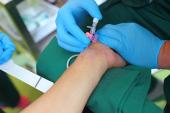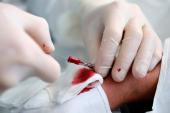RIVARAD: Rivaroxaban a Possible Solution to Radial Artery Occlusion
The idea of preserving the radial artery for future needs, including CABG and hemodialysis, is important, Roxana Mehran says.

BOSTON, MA—For patients undergoing transradial coronary procedures, a short course of rivaroxaban (Xarelto; Bayer/Janssen) reduces the rate of radial artery occlusion without significantly increasing bleeding, the RIVARAD study shows.
At 30 days, ultrasound revealed occlusion in 6.9% of patients who were treated with rivaroxaban 10 mg for 7 days after their procedures and 13.0% of those who were not (OR 0.50; 95% CI 0.27-0.91), Rania Hammami, MD (Hedi Chaker Hospital, Sfax, Tunisia), reported here at TCT 2022.
Though BARC-defined hemorrhagic events were numerically higher in the rivaroxaban group, the difference didn’t reach statistical significance (2.7% vs 1.9%; OR 1.4; 95% CI 0.4-4.5).
Hammami said the incidence of radial artery occlusion is particularly high in Tunisia, adding that she has started using rivaroxaban after transradial procedures to treat patients who are at high risk. That includes women, current smokers, and those who have undergone previous transradial procedures. Hammami noted that based on this study, women who smoke and have a history of transradial procedures have a 50% chance of developing an occlusion in their radial artery after a subsequent procedure performed through the wrist.
“I think that our study will change practice, especially in patients who are at high risk of radial artery occlusion,” she told TCTMD.
RIVARAD
Radial artery occlusion is the most common complication of transradial access, affecting 0.8% to 33% of cases depending on how and when it’s assessed, Hammami said. She added that once it occurs, which can be immediately after the procedure or days later, the artery can no longer be used as an access site for future coronary procedures, a conduit for CABG, or a fistula for hemodialysis.
RIVARAD, conducted at five Tunisian centers and involving operators who had at least 5 years of experience with transradial procedures, was designed to evaluate whether prophylactic-dose rivaroxaban could mitigate the problem. After excluding patients with a high bleeding risk, the investigators randomized 538 (mean age 60 years; 32% women) who were undergoing coronary angiography and/or PCI to 7 days of rivaroxaban 10 mg or standard care (no rivaroxaban) after the procedure.
Most of the patients (60.7%) had NSTE ACS, 24.5% had chronic coronary syndrome, 9.6% had STEMI, and the rest had other indications for catheterization. PCI was performed in 35.1%. During the procedures, patients were treated with a cocktail of nitroglycerin, nicardipine, and unfractionated heparin. After the procedure, 41% of patients received aspirin alone and 47% received dual antiplatelet therapy (DAPT) with clopidogrel and aspirin.
Patent hemostasis was not used. Manual band compression was applied at the puncture site at the end of the procedure when the introducer sheath was removed. It took more than 6 hours to achieve hemostasis in about two-thirds of patients (67.3%).
I think that our study will change practice, especially in patients who are at high risk of radial artery occlusion. Rania Hammami
Overall, one in ten patients developed radial artery occlusion, with a lower rate in the rivaroxaban group. There was a discrepancy between the clinical exam and the ultrasound findings in 3.6% of patients. Physicians were able to detect a radial pulse in 12 patients who had occlusion on ultrasound, and in seven patients, there was no pulse despite the artery being patent. The proportion of patients in whom a radial pulse was not detected at 30 days was lower in the rivaroxaban arm (5.8% vs 12.2%; P = 0.01).
All 12 of the hemorrhagic complications observed by 30 days were minor bleeds (BARC 1), and none occurred in patients treated with rivaroxaban alone. Four were in patients on DAPT plus rivaroxaban, three in those taking aspirin plus rivaroxaban, three in those taking DAPT, and two in those taking aspirin.
On multivariate analysis, an increased likelihood or radial artery occlusion was seen in women (OR 3.71; 95% CI 1.74-7.90), current smokers (OR 3.96; 95% CI 1.85-8.49), and those with a prior transradial procedure (OR 2.07; 95% CI 1.07-3.98). Use of rivaroxaban was associated with lower odds (OR 0.47; 95% CI 0.25-0.87).
‘Intriguing’ Findings Require Confirmation
Commenting for TCTMD, Roxana Mehran, MD (Icahn School of Medicine at Mount Sinai, New York, NY), said “the idea of preserving [the radial artery] and making sure that there’s no radial artery occlusion, because there will be a future for the use of these arteries, is incredibly important.” She noted that surgeons who rely on the radial artery as a conduit for CABG when performing total arterial revascularization are concerned about this issue.
As for RIVARAD, Mehran said “these are intriguing data” to get operators thinking about preventing radial artery occlusion, whether that’s with anticoagulation or some other means. The findings regarding rivaroxaban, however, need to be confirmed in future studies, she said.
A prior single-center trial conducted in China—called RESTORE—evaluated the use of rivaroxaban to prevent radial artery occlusion. It didn’t meet its primary endpoint, failing to demonstrate a difference in the rate of occlusion at 24 hours between the rivaroxaban and control arms. But as in RIVARAD, there was a lower rate of occlusion in the rivaroxaban-treated patients at 30 days.
And more randomized data are forthcoming, as the ongoing CAPITAL-RAPTOR trial is aiming to randomize 1,800 patients to either rivaroxaban 15 mg for 7 days or standard care after transradial procedures.
Something that stood out from RIVARAD for Shrilla Banerjee, MBChB, MD (Surrey and Sussex Healthcare NHS Trust, Redhill, England), who participated in a panel discussion after Hammami’s presentation, were the high rates of smoking (47%) and diabetes (48%) among the participants. “Alongside all this radial artery occlusion, we need to be thinking about some public health messaging as well,” she said.
Hammami acknowledged, “We are really a country at very high risk of cardiovascular complications.” She pointed out, too, that one-third of Tunisians have obesity, which increases the risk of hemorrhagic complications when femoral access is used for coronary procedures. “So we have to really prevent occlusion of the radial artery” to protect that access point, she said.
Todd Neale is the Associate News Editor for TCTMD and a Senior Medical Journalist. He got his start in journalism at …
Read Full BioDisclosures
- RIVARAD was funded by Philadelphia Pharma (Tunisia).
- Hammami reports no relevant conflicts of interest.





Comments